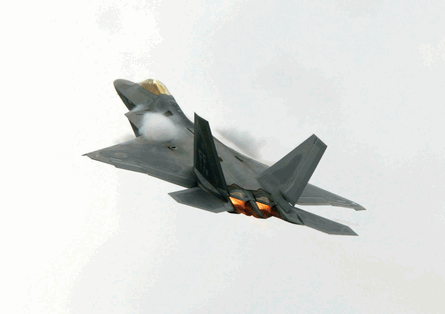Maj Paul Moga impressed Farnborough crowds on Monday in his startling one off flight demonstration of the F-22 Raptor - but questions still hang over the programme.
Increased Raptor procurement for the USAF still hangs in the balance. Lockheed Martin needs a decision by October 31 if it is to maintain the deals with its current supply chain. A gap in production could have huge cost implications if the next US Government administration wants more Raptors.
Before yesterday’s display, Larry Lawson, Lockheed Martin’s executive vice president for Raptor, said the company had so far delivered 122 aircraft of the 183 on order for the USAF.
Lawson proudly explained that 17 of the aircraft have been delivered as “perfect” zero defect aircraft – indeed, 7 of the last 10 aircraft delivered have met these stringent criteria. But USAF Raptors are currently experiencing a 70% miss
 |
|---|
ion-capable rate, with the 2.24h mean time between maintenance still falling short of the required 3.0h target.
The 3rd Wing at Elmendorf, Alaska, is currently receiving production aircraft and has so far taken 32 aircraft, with its last 8 due before year end when deliveries switch to the 49th FW at Holloman. Following the completion of deliveries to Holloman in 2010, the aircraft will start being delivered to the last current-planned operational wing at Hickam, Hawaii.
The USAF has trained 196 pilots and the first ab initio (B-Course) students are currently in training at Tyndall and scheduled to graduate in October.
Meanwhile, upgrades are on the way, with Increment 3.1 adding more air-to-ground capabilities. On July 13, the first supersonic SDB test drop marked a key milestone in this spiral upgrade. Increment 3.2 will further add AIM-9X and AIM-120D by 2012.
But the question still remains over Raptor’s ability to share datalinked information on the ‘global information grid’ – not just with other Raptors. Lawson says work is underway on a common datalink and this will initially allow Raptors to exchange secure data with F-35 and B-2s, with compatibility with other platforms planned to follow.
The other issue that won’t go away is the lack of helmet sight such as the joint helmet mounted cueing system (JHMCS). Without this, Raptor is at a distinct disadvantage against a dogfight opponent with a more robust high off boresight (HOBS) capability. Raptor can call upon thrust-vectoring to bring its foe into missile envelope, but an enemy with a helmet sight still presents a real threat.
Source: Flight International



















